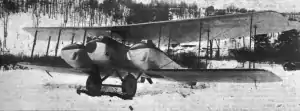Thomas-Morse MB-4
The Thomas-Morse MB-4 was a prototype American mailplane of the 1920s. It was of unusual design, being a biplane with twin fuselages housing the crew of two and a central nacelle which carried the aircraft's twin engines in a push-pull configuration.
| MB-4 | |
|---|---|
 | |
| Role | Mail plane |
| National origin | United States of America |
| Manufacturer | Thomas-Morse Aircraft |
| First flight | 1920 |
| Number built | at least 2 |
| Developed from | Thomas-Morse MB-3 |
Design and development
The MB-4 was designed to meet a June 1919 specification from the United States Post Office Department for a two- or three-engined mailplane, required to carry 1,500 lb (682 kg) of mail on a single engine.[1] Thomas-Morse chose to use as much as possible of its existing Thomas-Morse MB-3 fighter in order to reduce costs, using two engineless MB-3 fuselages to carry the crew and cargo, with the pilot in a cockpit in the nose of the port fuselage and the co-pilot/mechanic in a similar cockpit in the nose of the starboard fuselage, while cargo was carried behind the crew in each fuselage. Two 300 hp (224 kW) Wright-Hisso H V8 engines were mounted in a central nacelle between the two main fuselages in a push-pull configuration, with fuel tanks mounted between the engines.[1][2][3]
The MB-4's three-bay biplane wings were all new, with ailerons on the upper wing.[3] It had a conventional tailwheel undercarriage and had two separate tail assemblies, which were standard MB-3 empennages. Dual controls were fitted, with the pilot able to disconnect the co-pilot's controls, but there were no means of communication between the two cockpits.[1][2]
Operational history
The MB-4 made its maiden flight in February 1920.[1] While the aircraft had reasonable speed for the time,[3] it was otherwise poor, with one fuselage tending to take-off before the other, while the engines caused severe vibration which overloaded the aircraft's structure.[1][4] It was described as the "worst thing on wings" by Jerome Fried, the general plant superintendent of Thomas-Morse.[1]
One aircraft was tested by the US Post Office, but was not used for mail services, and was scrapped in 1921.[4] At least one MB.4[1] (and possibly 3[4]) was delivered to the United States Army Air Service where it was stored before being scrapped.[1]
The MB-4 was a failure, having extremely poor flying characteristics and being described as the "worst thing on wings",[1] and saw no service other than the trials by the manufacturer, US Army and the US Post Office.
Specifications
Data from General Dynamics Aircraft and their Predecessors[1]
General characteristics
- Crew: 2
- Length: 25 ft 5 in (7.74 m)
- Wingspan: 45 ft 6 in (13.87 m)
- Height: 11 ft (3.4 m)
- Wing area: 645 sq ft (59.9 m2)
- Empty weight: 3,554 lb (1,612 kg)
- Gross weight: 5,564 lb (2,524 kg)
- Powerplant: 2 × Wright-Hisso H water-cooled V8 engines, 300 hp (220 kW) each
Performance
- Maximum speed: 122 mph (196 km/h, 106 kn)
- Stall speed: 53 mph (85 km/h, 46 kn) [2]
- Range: 600 mi (970 km, 520 nmi)
- Time to altitude: 9,000 ft (2,745 m) in 10 min
References
- Notes
- Wegg 1990, p. 26.
- Flight 1 April 1920, p. 373.
- Eberspacher 2001.
- "Thomas, Thomas-Morse". aerofiles. 1 August 2008. Retrieved 22 January 2011.
- Bibliography
- Eberspacher, Warren. "Thomas-Morse MB-4". Excerpts from AAHS Journal, Vol. 46, No. 3 - Fall 2001.
- "New York Aero Show". Flight, 1 April 1920, pp. 370–373.
- Wegg, John. General Dynamics Aircraft and their Predecessors. London:Putnam, 1990. ISBN 0-85177-833-X.
External links
| Wikimedia Commons has media related to Thomas-Morse MB-4. |
- "Airisms from the Four Winds". Flight, 25 March 1920. p. 350. (Contains two photos of the MB-4).